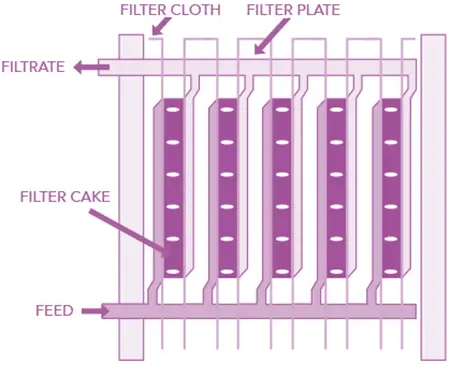Principle of Plate & Frame Filter
- The plate and frame filter press operates on the principle of pressure filtration.
- A slurry (mixture of solid particles and liquid) is pumped into the press, and pressure is applied to separate the solid particles from the liquid.
Construction of Plate & Frame Filter
- Filter Plates: Flat plates with grooved surfaces to allow liquid to flow.
- Filter Frames: Hollow frames that hold the slurry.
- Filter Cloth: Porous cloths that cover the plates to retain solids.
- Hydraulic System: Applies pressure to compress the plates and frames.
- Feed Pump: Pumps the slurry into the press.

The plates and frames are arranged alternately and held together in a sturdy frame. The filter cloth is placed between each plate and frame to form a seal.
Advertisements
Working
- The slurry is pumped into the frames.
- Pressure is applied using a hydraulic system, compressing the plates and frames.
- The liquid passes through the filter cloth, leaving the solid particles behind to form a filter cake.
- The filtrate is collected and drained off, while the solid cake remains between the plates.
- Once the cycle is complete, the press is opened, and the filter cake is removed.
Uses
- Pharmaceutical industry
- Food and beverage industry
- Chemical manufacturing
- Wastewater treatment
Merits
- High filtration efficiency.
- Produces a dry filter cake.
- Suitable for small to medium batches.
Demerits
- Labor-intensive.
- High maintenance cost.
- Not suitable for continuous operation.
Click Here to Watch the Best Pharma Videos
Advertisements

